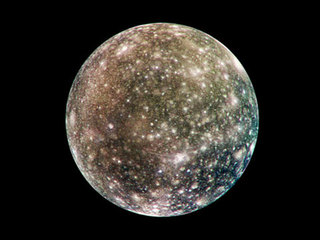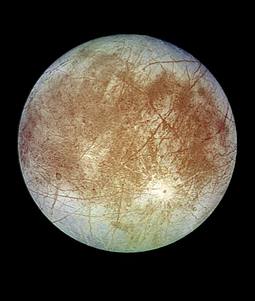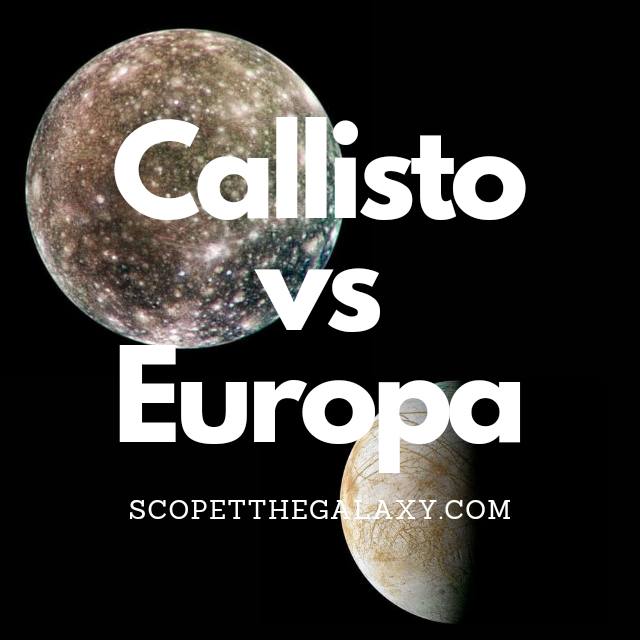*This post may contain affiliate links. This means we may make a commission if you purchase an item using one of our links*
The main differences between Callisto and Europa is that Callisto is the 3rd largest moon with a diameter of 4,820.6km whilst Europa is the 6th largest moon with a diameter of 3,121.6km, Europa has water ice present on its surface whilst Callisto doesn’t and Callisto is amongst the most cratered entities in the solar system, displaying much more than Europa.
There are various other differences between the two so continue reading for a more detailed look at each of these natural satellites below along with their similarities and differences below.
What Is The Moon Callisto?
Table of Contents

Callisto is one of the large moons orbiting Jupiter, the outermost of the Galilean moons, first discovered on 7th January 1610. The surface of this icy world is frozen, but scientists believe an underground ocean could reside beneath the ice.
Even if there’s water on Callisto, it won’t necessarily hold life because the surface is so old. Scientists will need to conduct more research into the moon before determining whether this is a likely possibility.
The ESA’s JUICE (Jupiter Icy Moon Explorer) mission is focused on the three ice moons of Jupiter. It is expected to arrive in 2030 and will focus on learning more about the environment of each, as well as their potential for hosting life.
Scientists estimate that Callisto is around 4.5 billion years old (the same age as Jupiter), and its average distance from the Sun is approximately 778 million km. It has a diameter of 4,820.6km, which makes it similar in size to the planet Mercury, and the average temperature is a frigid minus 139.2 degrees Celsius.
Callisto takes seven days to orbit its planet at an average distance of 1,880,000km, and it is tidally locked, meaning the same side of it always faces Jupiter. But this moon experiences less tidal influence than the other Galilean moons because it lies in the orbit of Jupiter’s primary radiation belt.
The name of this moon is derived from the stories of Greek myth. Callisto was the nymph who had an affair with Zeus, the King of the Gods. Upon hearing this news, Zeus’ wife Hera turned Callisto into a star and placed her in the Ursa Major constellation. Interestingly, every moon of Jupiter is named after a Greek figure who Zeus seduced.
Callisto may be the third biggest moon and similar in size to the planet Mercury, but it only has a mass of 107,593,737,963.819 billion kg. That may sound like a lot, but it’s only ⅓ the mass of the similarly sized Mercury.
You may wonder why scientists classify Callisto as a “moon” rather than a planet if it’s almost the same size as Mercury. The reason is simple; planets must orbit the sun, but Callisto orbits one of the planets.
The composition of this frigid world is around 60% rock and iron and 40% ice. The moon has roughly equal amounts of rock and ice, plus the potential for water below the surface. There are also traces of carbon dioxide, organic compounds, and silicates.
This moon is one of the oldest landscapes in the Milky way and the most heavily cratered body in our system. However, scientists believe this could now be a “dead” moon as there are no longer any signs of volcanism or plate tectonics on its surface.
What Is The Moon Europa?

Europa is the smallest of the Galilean moons, first discovered on 8th January 1610. The surface of this icy world is frozen, but scientists believe a watery ocean could lie beneath the surface. And in 2012, researchers found a possible water plume in the Southern polar region of Europa.
This research is yet to be confirmed; still, it gives us reasonable grounds to hypothesize that water could exist on this icy moon.
Estimates place Europa at around 4.5 billion years old (the same age as its planet, Jupiter), and its average distance from the Sun is approximately 780 million km.
It has a diameter of 3,121.6km, which makes it larger than Pluto but smaller than the Earth’s moon, and the maximum temperature is a chilly -160 degrees Celsius. In regards to mass, it measures in around 4.8 × 10^22 kg.
Europa takes three-and-a-half days to orbit its planet at an average distance of 670,900km, and it is tidally locked, meaning the same side of the moon always faces Jupiter.
Among the fascinating features of this ice moon is its incredibly reflective nature. The icy crust of this body provides a light reflectivity of 0.64 – the highest of any moon in the solar system.
Data from the Galileo spacecraft suggests that Europa is composed of an iron core, rocky mantle, and silicate rock (a similar composition to Earth).
The moon’s surface is covered in cracks, which many theorize could result from tidal currents beneath the surface. It is this potential of water – and of life – that keeps astronomers so interested in this moon.
Europa might be small, but astronomers estimate it holds two to three times more water than the Earth. In addition, this moon possesses the essential elements for life, such as carbon, oxygen, hydrogen, and nitrogen.
There may be no solar energy on this moon, but hydrothermal vents could provide energy, and tidal heating from Jupiter could provide a heat source and keep the moon stable enough for life to form. In addition, the liquid ocean is well protected from radiation from thick, icy surfaces.
Similarities Between Callisto And Europa
As both Callist0 and Europa are moons, they do share a few similarties, which in this case includes
- Europa and Callisto are two of Jupiter’s moons.
- Galileo discovered both Europa and Callisto in the 17th century.
- They both have a terrestrial based composition.
- Both moons are tidally locked to Jupiter, so the same side always faces toward the planet.
- Neither have a magnetosphere.
- Neither have other moons orbiting them.
- Both orbit Jupiter ellipticaly.
- Both have no rings surrounding them.
Differences Between Callisto And Europa
As for the differences between the two, they include the following:
- Europa is the 6th largest moon whilst Callisto is 3rd as Europa has a diameter of 3,121.6km whereas Callisto has a diameter of 4,820.6km.
- The average temperature on Callisto is -139.2 degrees Celsius whilst Europa has a temperature of -160 degrees Celsius.
- Callisto has a practically non-existent atmosphere composed mostly of hydrogen and oxygen whilst Europa’s atmosphere is also very thin but composed mostly of oxygen.
- Callisto is one of the most cratered entities in the solar system surface whilst Europa is the made up of water ice and rock.
- Callisto is 1.88 million km away from Jupiter on average whilst Europa’s average distance is 442,200km from Jupiter.
- Callisto’s has an albedo/luminosity of 0.22 whilst Europa is the most luminous moon with an albedo of 0.64.
- Callisto’s gravitational strength is 1.236 m/s² whilst Europa’s gravity is 1.315 m/s².
- Europa has a density of 3.01 g/cm³ whilst Callisto’s density is 1.83 g/cm³.
- A day on Europa is 3.5 days whilst a day on Callisto takes 17 days.
- As both satellites are tidally locked to their planet, it takes them both the same as a day to orbit their planet meaning Callisto takes 17 days and Europa completes an orbit in 3.5.
- In regards to mass, Callisto’s is 1.07 x 10^23 kg whilst Europa’s is 4.8 × 10^22 kg
Summary
Europa and Callisto have a few common features between them, such as the fact both are Galilean moons and amongst the largest moons in the entire solar system, have a similar composition and more.
However, they have various differenences too whether it be in regards to their overall size, their atmospheric composition, the activity on their surface and more so, Callisto and Europa are very unqiue depsite orbiting the same planet, Jupiter.

